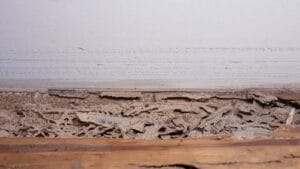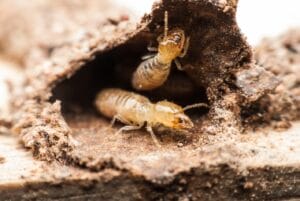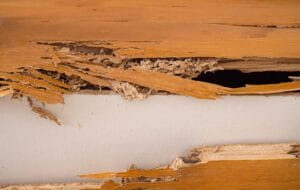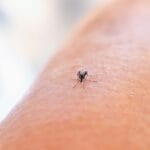Key Takeaways
- Most homeowner’s insurance policies do not cover termite damage, but exceptions exist.
- Understanding the signs of termite damage is crucial for early intervention and prevention.
- Only specific ‘covered perils’ may lead to insurance coverage for termite-related damage.
- Documenting termite damage thoroughly is key when filing a claim with your insurance.
- Proactive measures and regular inspections are the best defense against termite damage.
Termite Troubles? Navigating Your Home Insurance Policy

Discovering termite damage in your home can be a homeowner’s nightmare, but understanding your insurance policy’s fine print can help you navigate this tricky situation. Let’s dive into what’s typically covered and what you might be responsible for out-of-pocket.
What is and isn’t covered under most policies
Most insurance policies consider termite damage preventable and therefore don’t cover it. However, there are rare circumstances where coverage is possible. It’s essential to review your policy and understand the specifics of what is termed a ‘covered peril.’
Defining ‘comprehensive coverage’
Comprehensive coverage sounds all-encompassing, but when it comes to termites, it’s anything but. This part of your policy generally includes sudden and unforeseen damage, not the gradual harm termites cause over time.
Identifying Termite Damage
Early signs of termite infestation
Early detection of termites can save you a lot of trouble and money. Look for telltale signs such as wood that sounds hollow when tapped, discarded wings near windows or doors, and mud tubes on exterior walls. If you spot these signs, act fast.
Long-term impact of unchecked termite damage
If left unchecked, termites can cause significant structural damage to your home. This not only compromises the safety of your living space but can also lead to a substantial financial burden, as the cost of repairs will not likely be covered by your insurance.
Therefore, if you suspect termites, contact a professional pest control service immediately. They can confirm the presence of termites and help you take the necessary steps to eradicate them and prevent future infestations.
Rare instances where termite damage is covered
Most homeowners’ insurance policies do not cover termite damage because it’s considered preventable. However, if termites cause a sudden incident, such as a collapsed structure that leads to further damage, your policy might cover the resulting losses. This doesn’t mean the actual termite damage is covered, but the secondary damage could be. It’s vital to understand these nuances when reviewing your policy.
Understanding ‘covered perils’ that link to termite damage
‘Covered perils’ are specific events your insurance policy protects against. These typically include fires, storms, and theft. If termites chew through your home’s wiring and cause a fire, the fire damage might be covered because it’s a peril listed in your policy, despite the termites themselves not being covered.
Step-by-Step Claim Filing Process

Filing a claim for termite damage, or resulting damage, requires careful documentation and prompt action. Here’s how to navigate the process:
First, review your insurance policy to confirm whether any aspect of the termite damage might be covered. If you believe there is a chance for coverage, begin the claims process immediately to avoid any delays.
Documenting termite damage for your claim
For a successful claim, detailed documentation is essential. Take photographs of the damage and collect any pest control reports. Maintain a record of repairs and costs associated with mitigating the damage. These will be crucial when discussing the claim with your insurance company.
8 Tips for Assessing Home Damage
- Inspect your home regularly for signs of termites, such as mud tubes and hollow-sounding wood.
- Use a flashlight and screwdriver to probe wood for weakness.
- Check crawl spaces, attics, and basements thoroughly.
- Keep a maintenance log with dates of inspections and findings.
- Consult with a professional for an annual termite inspection.
- Take immediate action if any termite activity is detected.
- Preserve damaged materials for the insurance adjuster’s inspection.
- Stay organized with all your termite-related documents in one place.
Expert advice: Getting an adjuster’s inspection
Once you’ve documented the damage, contact your insurance company to request an adjuster’s inspection. Be present during the inspection to provide any necessary information about the damage and the steps you’ve taken since discovering the termites.
Prevention is Better Than Cure: Termite Protection Tips

Preventing termite damage is the most effective strategy to protect your home and avoid the complications of filing a claim. Here are some measures you can take:
Regular maintenance and inspections
Conducting regular inspections and maintenance on your property is key. This includes checking for cracks in the foundation, ensuring proper drainage away from the home, and sealing entry points that might allow termites to enter.
Proactive treatments and barriers
Investing in termite prevention treatments and physical barriers can be a wise decision. Consider consulting with pest control professionals to apply treatments around your home’s foundation and other vulnerable areas.
Remember, while insurance may not cover termite damage, taking proactive steps to protect your home can save you from the stress and cost of dealing with these destructive pests.
Frequently Asked Questions
As homeowners grapple with the realities of termite damage and insurance claims, several questions frequently arise. Here are some answers to help clarify these concerns.
Can termite prevention costs be covered by insurance?
Typically, termite prevention costs are not covered by standard homeowners insurance policies. Insurance is designed to cover sudden and accidental damage, not maintenance issues. However, investing in termite prevention is still a smart financial decision to protect your property from potential damage.
What should I do if I discover termite damage after purchasing a new home?
If you find termite damage after buying a home, reach out to a professional pest control service to assess the extent of the infestation and damage. You should also review your home inspection report to see if the damage was noted before purchase and consult with a real estate attorney to understand your options.
It’s important to act quickly to address the damage and prevent further deterioration of the property. Depending on the situation, you may have legal recourse against the seller if the damage was known and not disclosed.
Furthermore, if you have a home warranty that covers termite damage, this could provide some financial relief. Make sure to check the terms of your warranty for coverage details.
How often should I have my home inspected for termites?
Experts recommend having your home inspected for termites at least once a year. If you live in an area with a high termite risk or have had termites before, you might consider more frequent inspections. Regular inspections can catch infestations early before they cause significant damage.
Are termite bonds or warranties worth the investment?
Termite bonds or warranties can be a worthwhile investment, especially in areas prone to termite infestations. These contracts with pest control companies often include regular inspections, treatment if termites are found, and sometimes even damage repair. Be sure to read the fine print and understand what’s covered under the bond or warranty.
Remember, the cost of a termite bond or warranty could be significantly less than the expense of repairing extensive termite damage out of pocket.
What are the signs that indicate a termite insurance claim might be successful?
A termite insurance claim may be successful if the damage is caused by or results in a covered peril under your policy. For example:
- If termites damage a support beam, causing a collapse that results in water damage from a burst pipe, the water damage may be covered.
- If termite damage leads to an electrical fire, the fire damage might be covered as fire is a covered peril in most policies.
However, the termite damage itself is unlikely to be covered. Success in these claims often hinges on the insurer’s determination of the proximate cause of the damage and whether it falls under a covered peril.







